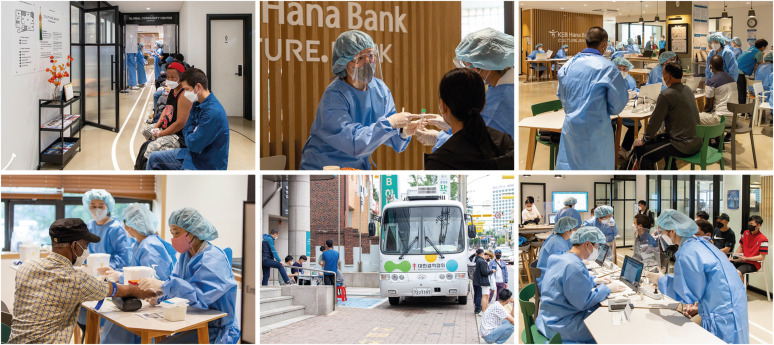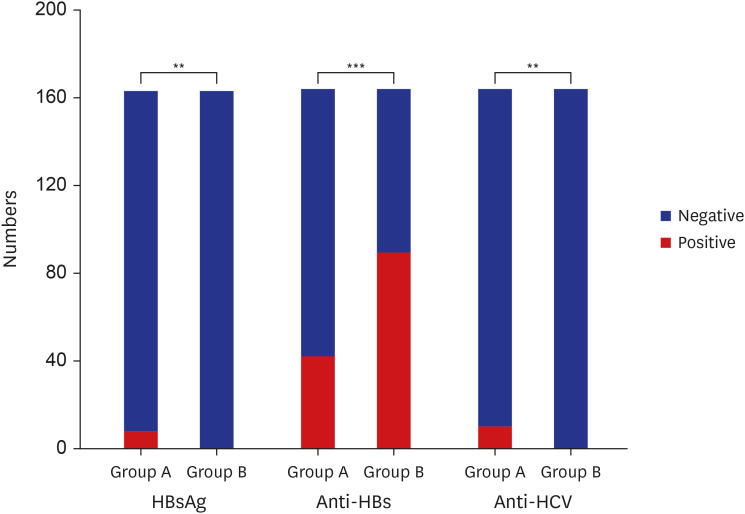J Korean Med Sci.
2023 Nov;38(46):e398. 10.3346/jkms.2023.38.e398.
The Health Status and Management of Migrant Workers in Cheonan: A Comparison Study With Korean Citizens
- Affiliations
-
- 1Department of Plastic and Reconstructive Surgery, Dankook University Hospital, Cheonan, Korea
- 2School of Medicine, Dankook University, Cheonan, Korea
- 3Department of Plastic and Reconstructive Surgery, Dankook University College of Medicine, Cheonan, Korea
- 4Raphael Clinic Cheonan Branch, Cheonan, Korea
- KMID: 2548546
- DOI: http://doi.org/10.3346/jkms.2023.38.e398
Abstract
- Migrant workers face challenging working conditions, resulting in physical and mental vulnerability. The objective is to identify their health vulnerabilities and ensure their right to health. Health records of 163 migrant workers (113 males and 50 females) (Group A) and 163 Korean citizens (Group B) visiting our institution were analyzed from August 2021 to July 2022. Both groups underwent urine analysis, chest radiography, and various blood tests. Statistical analysis using independent t-tests and χ2 tests was performed. Group A had a significantly higher rate of hepatitis B virus surface antigen-positive patients, lower vaccination rates for hepatitis B, and poorer nutritional status compared to Group B. Group B generally exhibited higher levels of albumin, glucose, total cholesterol, and thyroidstimulating hormone. There were significant quantitative differences in multiple blood cell and hemoglobin measurements between the two groups. These findings emphasize the need for policy support and public awareness to protect the health rights of migrant workers.
Keyword
Figure
Reference
-
1. Kwak YK, Wang MS. Exclusion or inclusion: National differential regulations of migrant workers’ employment, social protection, and migrations policies on im/mobilities in East Asia-examples of South Korea and Taiwan. Int J Environ Res Public Health. 2022; 19(23):16270. PMID: 36498343.
Article2. Ministry of Justice (KR). Statistics of visiting foreigners. Updated 2023. Accessed March 20, 2023. https://www.moj.go.kr/moj/2412/subview.do .3. Lee H, Chae D, Yi KH, Im S, Cho SH. Multiple risk factors for work-related injuries and illnesses in Korean-Chinese migrant workers. Workplace Health Saf. 2015; 63(1):18–26. PMID: 25791407.
Article4. Lee H, Ahn H, Miller A, Park CG, Kim SJ. Acculturative stress, work-related psychosocial factors and depression in Korean-Chinese migrant workers in Korea. J Occup Health. 2012; 54(3):206–214. PMID: 22790523.
Article5. Kang SJ, Hwang J, Kim D, Kim B. Factors associated with self-rated health among immigrant workers in South Korea: analyzing the results of the 2020 survey on immigrants’ living conditions and labor force. Front Public Health. 2022; 10:933724. PMID: 36211667.
Article6. National Assembly Research Service (KR). Current status of foreigners’ health insurance system and improvement direction for enhancing acceptance of subscribers. Updated 2022. Accessed March 20, 2023. https://www.nars.go.kr/report/view.do?cmsCode=CM0043&brdSeq=38792 .7. Wickramage K, Vearey J, Zwi AB, Robinson C, Knipper M. Migration and health: a global public health research priority. BMC Public Health. 2018; 18(1):987. PMID: 30089475.
Article8. Hargreaves S, Rustage K, Nellums LB, McAlpine A, Pocock N, Devakumar D, et al. Occupational health outcomes among international migrant workers: a systematic review and meta-analysis. Lancet Glob Health. 2019; 7(7):e872–e882. PMID: 31122905.
Article9. Pega F, Govindaraj S, Tran NT. Health service use and health outcomes among international migrant workers compared with non-migrant workers: a systematic review and meta-analysis. PLoS One. 2021; 16(6):e0252651. PMID: 34106987.
Article10. Zimmerman C, Kiss L, Hossain M. Migration and health: a framework for 21st century policy-making. PLoS Med. 2011; 8(5):e1001034. PMID: 21629681.
Article11. Lee YM. Health policy for the people. J Korean Med Assoc. 2017; 60(4):286–288.
Article12. Koo JN. Considerations regarding medical services for undocumented migrant workers. J Korean Med Assoc. 2015; 58(11):970–974.
Article13. Ahn J, Lee J, Lee SH, Park MY, Lee W. The occupational characteristics and health status of workers in geographically isolated and confined areas in the Republic of Korea. J Korean Med Sci. 2021; 36(17):e119. PMID: 33942580.
Article14. Korea Disease Control and Prevention Agency. Achieving the regional goal of the hepatitis B control in Korea. Updated 2023. Accessed on March 20, 2023. https://kdca.go.kr/index.es?sid=a2 .15. Nguyen TD, Dang AD, Van Damme P, Nguyen CV, Duong HT, Goossens H, et al. Coverage of the expanded program on immunization in Vietnam: results from 2 cluster surveys and routine reports. Hum Vaccin Immunother. 2015; 11(6):1526–1533. PMID: 25970593.
Article16. Lahariya C, Subramanya BP, Sosler S. An assessment of hepatitis B vaccine introduction in India: lessons for roll out and scale up of new vaccines in immunization programs. Indian J Public Health. 2013; 57(1):8–14. PMID: 23649136.
Article17. Patel MK, Capeding RZ, Ducusin JU, de Quiroz Castro M, Garcia LC, Hennessey K. Findings from a hepatitis B birth dose assessment in health facilities in the Philippines: opportunities to engage the private sector. Vaccine. 2014; 32(39):5140–5144. PMID: 24361121.
Article18. Suvedi BK. Twenty-five years of immunization program in Nepal. Kathmandu Univ Med J (KUMJ). 2005; 3(1):4.19. Joseph L, Fauci A, Kasper D, Hauser S, Longo D, Jameson JL. Harrison’s Principles of Internal Medicine. 21st ed. New York, NY, USA: McGraw-Hill;2020.20. Shin BM, Yoo HM, Lee AS, Park SK. Seroprevalence of hepatitis B virus among health care workers in Korea. J Korean Med Sci. 2006; 21(1):58–62. PMID: 16479066.
Article21. Choe JW, Jung YK, Yim HJ, Seo GH. Clinical effect of hepatitis B virus on COVID-19 infected patients: a nationwide population-based study using the health insurance review & assessment service database. J Korean Med Sci. 2022; 37(4):e29. PMID: 35075828.
Article22. Schalk BW, Visser M, Bremmer MA, Penninx BW, Bouter LM, Deeg DJ. Change of serum albumin and risk of cardiovascular disease and all-cause mortality: Longitudinal Aging Study Amsterdam. Am J Epidemiol. 2006; 164(10):969–977. PMID: 16980573.
Article23. Ota A, Kondo N, Murayama N, Tanabe N, Shobugawa Y, Kondo K, et al. Serum albumin levels and economic status in Japanese older adults. PLoS One. 2016; 11(6):e0155022. PMID: 27276092.
Article24. Statistics Korea. Social statistics by life class. Updated 2023. Accessed March 20, 2023. https://kosis.kr/statHtml/statHtml.do?orgId=101&tblId=DT_1MA0030&conn_path=I2 .25. Statistics Korea. Survey on immigrant status and employment. Updated 2023. Accessed March 20, 2023. https://kosis.kr/statHtml/statHtml.do?orgId=133&tblId=DT_133N_1234&conn_path=I2 .26. Abramson N, Melton B. Leukocytosis: basics of clinical assessment. Am Fam Physician. 2000; 62(9):2053–2060. PMID: 11087187.27. Kim HR, Kim TW. Occupational hepatic disorders in Korea. J Korean Med Sci. 2010; 25:S36–S40. PMID: 21258588.
Article28. Moon S, Han JH, Bae GR, Cho E, Kim B. Hepatitis A in Korea from 2011 to 2013: current epidemiologic status and regional distribution. J Korean Med Sci. 2016; 31(1):67–72. PMID: 26770040.
Article29. Yeom JS, Kwon KT, Lee J, Suh YB, Cheong HS, Kwon HH, et al. Vaccination guideline for immigrant in Korea by Korean Society of Infectious Diseases. Infect Chemother. 2015; 47(2):145–153. PMID: 26157598.
Article30. Kim KT, Kwak YK, Lee JM, Chu YS, Chung KS, Kim SH. A Study of the Development of a New Welfare State for Coping With Social Exclusion: On Immigrant Workers. Sejong, Korea: Korea Institute for Health and Social Affairs;2020.31. Statistics Korea. International population migration statistics. Updated 2023. Accessed March 20, 2023. https://kosis.kr/statHtml/statHtml.do?orgId=101&tblId=DT_1B28025&conn_path=I2 .
- Full Text Links
- Actions
-
Cited
- CITED
-
- Close
- Share
- Similar articles
-
- Influential Factors of Psychological Well-Being of Migrant Workers
- The Status and Characteristics of Industrial Accidents for Migrant Workers in Korea Compared with Native Workers
- Factors Influencing Level of Health Literacy of Migrant Workers in Korea
- The Influence of Social Support on Job Satisfaction of Migrant Workers
- The Health Status Including Biologic Exposure Indices of Migrant Workers: Based on 2005 Special Health Examination Data



